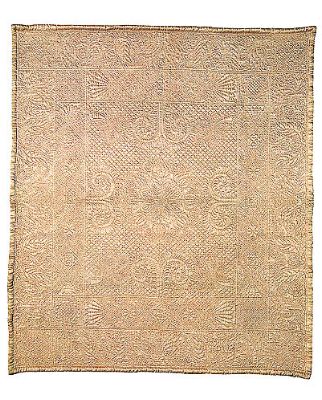Quilt No.1032NG - Narelle Grieve

Found by the present owner in a plastic bag at a garage sale in the suburb of Gordon Sydney NSW. Thought to have been designed and possibly made by Miss G.K.Evans, later Mrs Boundy, in Wales in the 1930s. The quilt's history from the 1930s to the garage sale is unknown. It is not used.
���"Months after salvaging the quilt from a garage sale in the Sydney suburb of Gordon, Narelle noticed a photograph of an almost identical quilt in Dorothy Osler's book 'Traditional British Quilts'. Correspondence with the author in Britain confirmed the possibility that the two quilts were almost certainly designed and perhaps made by the same quilter, Miss G.K.Evans (later Mrs. Boundy).
��It is assumed that Miss Evans designed and created the quilts during her time under the Rural Industries Bureau Scheme which operated in southern Wales and north east England in the 1930s. The scheme was an attempt to revive enthusiasm for the art of quilting, which had diminished in the regions following the invention of the sewing machine and the consequent desire for machine made bedcovers.
Under the scheme, the Rural Industries Bureau financed an exhibition of traditional Welsh quilts for a display in London. The display, which also included Durham quilts from the north-east of England, was such a success that it resulted in a rush of orders for the designs. The small population of Welsh quilters commissioned by the bureau was unable to cope with the demand and classes in quilting were begun to teach the art.
Under the scheme payment for quilting was good and it attracted many young women, who quickly learned and adapted the traditional techniques taught to them by the more experienced quilters.
This quilt and the one found in Dorothy Osler's book exhibit the traditional designs and styles taught in south Wales during this period. But they also share unique characteristics, such as the tulip motifs which can be attributed to the imagination of Miss Evans." [extract from unidentified magazine article supplied by the present quilt owner.]
Related Quilts:
11920 x 1830mm
2000 x 1600mm
2236 x 2236mm






